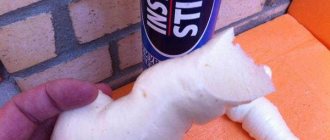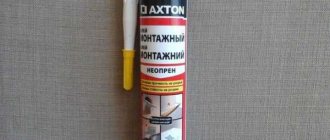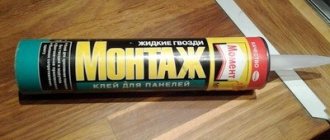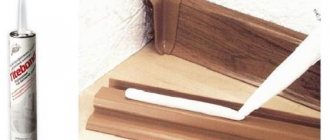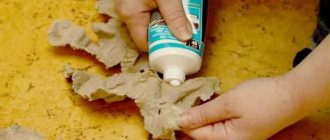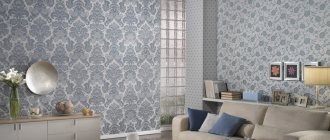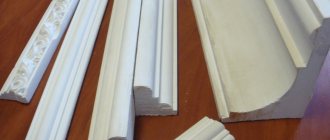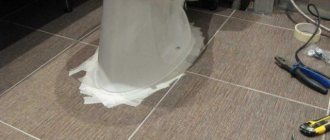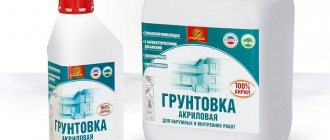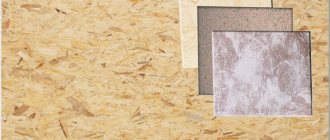Types of kitchen aprons
Protective screens are made from a variety of materials. Accordingly, how it is attached and which apron to choose for the kitchen depends on the characteristics of the material. The most common options are:
- An apron in the kitchen can be made of plastic - this is the most affordable and budget option, although not very durable. The materials are quite sensitive to heat and only polycarbonate models are allowed to be installed near a gas stove, since its temperature resistance is slightly higher - +120° C versus +80° C.
They are used as opaque plastic - PVC panels, as a rule, and transparent - acrylic or polycarbonate glass. Imitates any natural or artificial material: stone, wood, tile, leather. The materials are lightweight, easy to cut and fastened with both self-tapping screws and glue.
- A kitchen apron made of chipboard is also a very budget option, but is just as short-lived as plastic. The material swells quite quickly when exposed to moisture and does not tolerate temperature changes. It cannot be used as a protective screen around the stove.
- MDF is a chipboard of high strength and density. Unlike chipboard, the material tolerates moisture well and does not change shape under the influence of temperatures. Its durability is higher, but inferior to both glass and ceramics. Attaching MDF panels is quite simple: the boards are lightweight and easy to cut. This material allows additional design - photo printing, for example.
- Glass – glass panels or sheets. Resistant to temperature and moisture in any form, does not accumulate dirt, is easy to clean, and is one of the most hygienic models. Disadvantage: installing an apron with your own hands is very difficult. In principle, you cannot install the skins yourself, since the weight of the product is very large. In addition, the cost of the material is quite significant.
- Ceramic tiles are an option that is both affordable and has all the necessary qualities. Ceramics are insensitive to steam, water, and even the highest temperatures. Even a beginner knows how to install a tile backsplash. In addition, it is a very decorative material.
General characteristics
MDF boards are produced from wood industry waste. These are small shavings that are pressed with a binder, “wood glue” and lignin. MDF is a more environmentally friendly material than chipboard. The formaldehyde emission class is E1, therefore, it is safe for human health, like natural wood.
On sale you can find panels that are completely ready for installation: laminated, veneered or painted . Who prefers which ones ?
But often a laminated version of standard sizes is chosen for the apron: 4 × 2440 × 60 centimeters. For wall coverings, it is better to select longer MDF kitchen wall panels. For example, the manufacturer Egger offers material with a length of 2700 centimeters.
MDF wall panels for the kitchen have a lot of advantages, it’s not for nothing that they can be found so often in the kitchen interior . But the main advantages include:
- Resistant to air humidity and moisture. In this criterion, wood is much inferior to MDF.
- Installation does not require a specialist to carefully level the frame; you can quickly install them with a minimum of construction knowledge and skills; in the case of glass and ceramic tiles, installation is extremely difficult to do on your own.
- Strength. The material can easily withstand accidental impacts, as its density is high.
- Easy care. Cleaning MDF is very easy, even easier than wood, glass or tiles, which have many seams.
- Design ideas. You can take imitation stone or wood, material to match the kitchen countertop and any other options.
- Low cost compared to stone, wood, agglomerate or porcelain stoneware. Wall panels can even be placed with a gap on the sheathing - this allows ventilation or electrical wiring to be installed underneath them.
- If you decorate the rest of the walls in the kitchen with MDF panels, it will become much warmer and quieter there.
Of course, the ideal material has not yet been invented; these panels are no exception. Its disadvantages are the following:
- The panels do not tolerate high temperatures well; it is not advisable to mount them next to the stove. They often become deformed from overheating.
- The ends are their weak point. If they are open, moisture may enter them. They are also subject to mechanical damage.
- Instability to damage from sharp objects and scratches. If you accidentally lightly touch the wall with a knife, then nothing terrible will happen, but if you press with force, the top decorative layer will peel off.
- Unnaturalness. MDF panels are still inferior to natural stone or wood in this regard, even though they may have very high-quality photo printing depicting these natural materials.
Despite the presence of disadvantages, the panels are in demand, because they have many more advantages.
Features and functions of a kitchen apron
An apron protecting the area above the work surface must be organically integrated into the interior. It should be in harmony with the rest of the decor, maintaining the style and mood of the room. An apron can become the main accent against the background of a seasoned set.
First of all, this element is introduced to protect the wall. However, the aesthetic component is not alien to him, so every now and then new original ideas are born regarding the design of this wall. But creativity has the right to exist only if it does not contradict the basic requirements. He must have:
- resistance to heat - if there is a built-in stove. Despite the fact that induction cookers do not heat up, the surface of the wall next to them may suffer from proximity to boiling pots and hot frying pans, and be attacked by grease and hot steam;
- moisture resistance - there is plenty of dampness in the kitchen, and especially in this area. This includes splashes of water from the sink and steam from cooking food;
- environmental friendliness - in case of possible contact with products, it should not saturate them with toxic emissions;
- hygienic - the surface absorbs moisture, grease and dirt - a favorable environment for the development of bacteria and fungus. Therefore, the finish must have a dense structure and a moisture-resistant coating;
- maximum fire resistance - this is especially important in close proximity to open fires of gas burners;
- be easy to clean - the surface texture should not create obstacles during cleaning. This also applies to resistance to household chemicals and mold resistance;
- aesthetic appeal - the finish should match the set and emphasize the advantages of the design.
Decorating a plastic apron
It is important not to make a mistake with the color of the apron. You cannot use dark colors in a Khrushchev apartment: they visually make the room feel cramped. For a small kitchen, choose light shades, they are in fashion today.
If transparent plastic is used, it can be decorated with photo wallpaper, colored film or other materials. To do this, you need to apply the design to the plastic. You can purchase panels with ready-made patterns, but if you want to be creative, use one of the methods listed.
Decorative painting
The apron can be painted with acrylic or oil paints. The plot should match the kitchen design. To apply the drawing, you can use templates or your own imagination.
Don't choose complex subjects. A modest, neat drawing looks much more impressive than poorly created intricate plots. Please note that the patterns must be applied in a mirror image, because the surface with the picture will be adjacent to the wall.
Photo wallpaper
The most popular and easiest way to decorate a transparent plastic apron is with photo wallpaper. The decor is glued onto a dry and absolutely clean plastic surface. Fine sand and other debris will prevent paper or film from adhering evenly to the plastic. Bulges and air bubbles under the wallpaper are considered defective.
If you are undergoing renovations in your home, there will be a lot of dust in the air. As it settles, it will ruin the result of your work. The entire pattern may become covered with small specks. This is especially true for small rooms.
It is more difficult to achieve clean air in a Khrushchev-era apartment than in a large apartment. Ventilate the room where decorative work is being carried out and do a wet cleaning.
The glue is applied directly to the drawing, that is, the picture should be under the plastic.
Film
Self-adhesive film is used for decoration. The choice of this material is huge. In addition, you can order interior printing on “self-adhesive” according to your photo or sketch. You need to glue slowly, removing the backing gradually. This is a job for neat people.
Before pasting, the plastic is sprayed with water so that the adhesive layer does not immediately adhere to the surface. From time to time, adjust the film and remove air bubbles. For renovations in a Khrushchev-era building, the color of the film is chosen based on the finish of the walls and countertops.
Application of ceramic and mosaic tiles
When wondering how to install a ceramic apron in a kitchen, you should remember that careful preliminary preparation of the surface is required. Concrete contact is considered a good way to treat a wall. It provides the surface with a certain roughness, thereby increasing the quality of adhesion between the tile and the wall.
This composition helps out if there is a painted surface using oil or alkyd enamel. Before attaching a ceramic apron to the wall, you need to carefully check the availability of sockets and install them before installing the apron. Correct calculation of the amount of materials required is the key to success in any job. To do this, the entire wall is measured, this is done very carefully, it is better to measure it several times than not to buy more material.
Advice
Before installation, please note that it is possible to trim the tiles. Therefore, it is pre-positioned in such a way that it requires cutting off a minimum amount of tiles. To begin work, you need to secure a horizontal strip, which will become a support for the bottom row of tiles. This stage allows you to lay out the tiles level.
After laying the first row, special crosses are inserted between the tiles, which help to create an even seam. Borders are used as decoration, laid between rows of tile trim. If there are unevenness on the surface, provided that they are small, the tiles are laid on a thick layer of glue; you can increase the layer to 10 mm; this option will help bypass the plastering stage.
You will have to work a little longer with mosaics; the process here is more complicated than with tiles. There is an option to make mosaic laying easier; this requires connecting several elements on a flexible base, which is attached to the wall. A special requirement is the choice of adhesive composition. It must be white tile adhesive, which is applied strictly with a notched trowel. The seams are rubbed down only after the adhesive solution has completely dried.
Rules for installing a PVC apron
Installation of a plastic apron in the kitchen is carried out after preparing the wall panels, which are cleaned of dust and dirt, leveled using primer, putty and plastering. When gluing thick plastic, you don’t have to perform complex repair work, because... the material will hide the deformations. After the repair is completed, the apron parts are fixed using self-tapping screws to minimize damage to the kitchen set.
Materials and tools
The PVC apron can be attached using the following tools and building materials:
- metal profiles;
- screwdriver;
- wood blocks;
- self-tapping screws;
- construction level;
- dowels for creating sheathing;
- ruler;
- special glue;
- yardstick;
- pencil or chalk;
- hammer.
Mounting methods
A plastic kitchen apron can be attached to the wall on:
- liquid Nails;
- self-tapping screws;
- lathing;
- special profiles;
Special profiles for guides
Fixing the apron on guide profiles is a budget-friendly and practical method. The installation technology allows you to change panels if you need to change the design without lengthy installation work. Guides are metal slats that are attached to the surface of the wall panel in a horizontal direction using self-tapping screws or construction staples. The cracks are hidden with sealant.
Self-tapping screws
When installing an apron at the stage of repair work when planning a design for a long period, it is recommended to use self-tapping screws. Plastic elements need to be drilled to create openings for fastenings. To implement this method, the surfaces of the wall panels should be leveled.
Traces from self-tapping screws on the facade are subsequently masked with plastic overlays in the same color scheme. The panels should not be tightly adjacent to the wall, so electrical wiring and other communication lines can be hidden under the facade. The fastening technology, if necessary, provides for dismantling and repair.
On the sheathing
You can attach the apron to the sheathing - using timber beams, thin slats, PVC guides or a galvanized profile. The technology is optimal for hiding gas pipes and water supply structures under the facade of the electrical wiring network. A small distance is left between the wall panel and the set. Wall surfaces must be treated with antiseptic compounds and antifungal impregnations. When using wooden beams, you need to lubricate the materials with a hydrophobic compound.
The beams for the sheathing, depending on the design of the project, are arranged horizontally or vertically. For sufficient structural strength there must be at least 3 pieces. The pitch of the lamellas in a horizontal arrangement is 200-400 mm. The elements are fixed using dowels, which are installed in increments of 250 mm. The beams must be symmetrically located, so a building level is used in the work.
On glue
You can glue the apron using special liquid nails. The wall must be smooth, without deformations. The installation method is characterized by high speed, ease of execution, and does not require the use of special equipment. If there is old wallpaper or putty on the walls, the materials are cleaned off. They also remove residual grease, dust and other contaminants. Then the surfaces are coated with a primer for rooms with high humidity, which has antifungal properties.
It is recommended to apply glue liberally to securely fix the materials. You need to install a bottle of glue in the gun and distribute the composition over the surfaces in zigzag strokes. The apron elements treated with glue are applied to the wall panel, pressed down, and left for some time until the adhesive base dries. For installation, it is recommended to choose sheets of standard sizes with a width of 600 mm and a length of 1000-3000 mm. The cutting of parts is also carried out according to the author's design project.
Panel preparation, layout, cutting
Before fixing the facade, the elements are prepared: the parts are assembled, the panels are cut. Wide panels are placed horizontally to reduce the number of joints. Narrow fabrics need to be cut and secured at vertical seams. The material is cut with a knife, scissors or a hacksaw. Work can be ordered from professional workshops that perform laser cutting.
Final finishing
The finishing stage involves closing the space between the apron and the work table with borders. The constructive solution will prevent moisture and dust from entering the cracks; will allow correction of work defects. The border can be flat, figured, triangular, rectangular in shape; it adds additional decorative value to the façade of the set. The elements are attached to an adhesive base. The finished look of the façade is given by corner overlays.
Decorating an apron
When planning a project, it is important to determine the design and techniques for decorating the backsplash in accordance with the color and stylistic scheme of the kitchen. For a small room, it is not recommended to use dark colors, which visually make the room smaller. It is recommended to purchase canvases in light shades or transparent panels with a printed pattern. The list of popular techniques for decorating panels includes painting, photo wallpaper, and films.
Decorative painting
Decorative painting in the design of an apron is effective. Acrylic paints, a sketch from a catalog or prepared according to an author's design will be useful for the work. Complex compositions are not recommended due to difficulties in execution and overloaded design of the typeface.
Before decorating, the coating is cleaned and degreased. Then the main tone is applied, and a drawing is made on top. The paint should be applied in a thin layer. The image is placed in the center of the apron or a repeating geometric or floral pattern is made.
A universal base tone can be a coating of the following colors:
- white;
- cream;
- grey;
- beige;
- olive;
- Ivory;
- metal;
- soft peach.
Painting is done with matte or glossy paints. The optimal solution for the kitchen is a small ornament that hides chips and scratches. Light colors allow you to visually enlarge the space; You can create accent areas using rich tones.
Photo wallpaper
A simple and effective method of decorating plastic facades is pasting with photo wallpaper. The material is applied to a dust-free surface. The adhesive base is smeared onto the photo image from the reverse side, then the coating is pressed against the apron. After the elements have dried, the apron is fixed to the wall.
Photo wallpapers are selected to match the style of the room and the texture of the room decoration.
Coverings can be:
- vinyl;
- non-woven;
- washable;
- acrylic;
- metal, etc.
Washable photo wallpapers are inexpensive and easy to clean. The materials are dense, waterproof, and smooth; presented in a wide range of shades. The canvases are attached to the leveled surfaces of the apron, because do not hide deformations.
Non-woven materials are produced with a special protective moisture-resistant coating. They are resistant to direct sunlight, dust, and can be easily cleaned. Pigmentation remains intact during use without damage.
Vinyl materials for photo wallpaper are durable, retain a rich tone, are easy to care for, and are resistant to moisture and household detergents. The sheets are dense, so they hide the unevenness of the walls. Materials are available matte or glossy, textured or embossed. The textures of wood, stone, Provençal ornaments, and original designs are reproduced on the coatings.
Film
Self-adhesive film allows you to quickly decorate the facade of your kitchen unit. Manufacturers offer a wide palette of shades, the ability to order photo printing with original prints of landscapes and paintings. The film is applied to a clean and flat surface. To improve adhesion qualities, the plastic is moistened with water and the location of the film is adjusted. It is necessary to remove the air under the coating.
When choosing a material, you need to take into account the colors of the kitchen. Saturated shades and contrasting combinations are optimal; for loft, Provence, and minimalist styles, light neutrals (brown, green, ocher, soft pink) are used. For a country-style kitchen, the optimal films are wood texture, imitation brickwork, stone.
Kitchen apron
A decade ago, it was impossible to use MDF panels for kitchen splashbacks due to the large thickness of the sheets and their unesthetic appearance. But now, thanks to new technological processes in the production of moisture-resistant MDF, the opportunity to implement different design solutions has become real.
If previously the main material used for the apron was tile, now owners have the opportunity to purchase a cheaper and easier-to-install finishing building material, MDF panels.
The kitchen is very capricious in terms of materials used for finishing, especially the area where the apron is located. It is this part that is exposed to external stimuli every day:
- humidity;
- heat.
So you should pay more attention to the characteristics of the finishing material you choose.
Kitchen apron
Those who want to decorate their kitchen do not always have the opportunity, in addition to purchasing all the necessary building materials, to also pay for the services of builders. And let's face it, hired workers often suck. Therefore, more and more people decide to do their own repairs.
This also raises a number of questions:
- how to install a kitchen apron made of MDF sheets?
- what materials are needed for installing MDF?
- What is better and how to attach a kitchen apron made of MDF?
- Is it possible to install a kitchen apron from MDF with your own hands?
- How to install an MDF apron in a kitchen, step-by-step instructions.
You will find answers to each of these questions here.
Decorating the walls in the kitchen with MDF panels (38 photos) - an interesting design option
Do you have a desire to make a good repair without dust, dirt, special financial and time costs? And do you want the renovated premises to function properly until the next renovation? Well, there is a solution - decorating the walls with MDF panels in the kitchen is an ideal option for those who value their time!
This material is a unique alloy of qualities that can rarely be found on the construction market: durable, warm, environmentally friendly, is an excellent sound and heat insulator, and its price is quite low.
Harmonious wall decoration with wood panels
Disadvantages of MDF
Before you start purchasing and installing an MDF apron in the kitchen, you should consider its shortcomings.
Perhaps they will become an obstacle to purchase. So:
- Negligence in care will affect the MDF board. She will be led or bent. The same applies to high humidity - you cannot mount MDF panels directly near the sink - it is better to install tiles there. The stoves must be equipped with hoods to prevent drops of condensation from settling on the surface of the apron.
- Material is flammable. This is important if the owners are planning to completely cover the wall from the edge of the set to the edge. Mandatory external control is required if a heat supply source is mounted on the wall - a gas boiler, for example.
The disadvantages are serious and should not be neglected. If, nevertheless, there are no prerequisites for future damage, then it is worth trying to create something new in the interior.
Dark furniture with an original pattern on the apron looks beautiful
Choosing MDF panels
The modern construction market has a wide selection of materials for interior decoration, among which the leading positions are occupied by wall panels, which have their own characteristic features in terms of operation and aesthetics.
When choosing wall panels, experts recommend paying attention, first of all, to the method of their fastening, to the texture and integrity of the pattern. In general, according to finishing professionals, the ideal option would be cladding, upon purchase of which you will be offered hardware, slats, corners, fasteners, clamps and other accessories necessary for fastening.
Note! MDF panels are not only a fine chip board with a smooth texture and a uniform wood pattern. If you ask the sellers, they will probably show you models with a rich range of colors. MDF panels can be decorated with patterns and create a complete picture, and can also be made with marble or wood imitation. And the texture ranges from the familiar smooth one to fabric analogues.
Velvet effect wall panels
This material has found wide application in cladding the premises of country houses, on balconies, in hallways, in the kitchen and in the living room - in other words, it can be installed wherever your heart desires.
Advantages and disadvantages
The advantages of this method include:
- there is no need to strip the wallpaper down to the plaster, clean the putty (the tiles don’t stick to it), or prime;
- With high-quality liquid nails, the apron holds very tightly;
- as mentioned above, the method is quite convenient, fast and clean.
Flaws:
- difficulties when dismantling such an apron. The glue penetrates deeply into the structure of the surface, and is often removed directly from the putty, plaster, or pieces of chipboard;
- high price of high-quality liquid nails (150-250 rubles for 1 bottle). Tile adhesive, for example, is cheaper;
- The glue is not applied to the entire surface, and voids remain in the apron. Therefore, it is better not to glue tiles in this way on surfaces that come into contact with water (in the bathroom, swimming pool, shower). Even if you cover all the seams with silicone grout, moisture will accumulate in the voids due to condensation, which can lead to mold. Due to the voids, this method is also not recommended when laying tiles on the floor (they may burst).
Types of panels and mounting features
The production form of kitchen panels involves three main types of finishes.
- Rack and pinion - like lining. The width of the lamellas ranges from 12.5 to 30 cm, different installations are possible - vertical, diagonal, combined. The design of the frame depends on the installation method.
- Panels (most often square or rectangular). The colors here are much richer, as they imitate wood, stone, ceramic tiles, and other materials. The sizes are different - from 30*30 to 98*98 cm. It is best to attach the tiles to the wall surface.
Particularly difficult is the installation of HPL-coated tiles. To attach them, you need not a simple sheathing, but a frame in the form of cells with a side of 30 cm.
- Sheet material , or panels, has very large sizes - from 122*244 cm, which allows installation quickly and with a minimum number of seams.
Preparatory stage
Attaching the apron necessarily includes preparatory work. Their nature is to some extent determined by the method of fixation. However, the general recommendations are the same for any type of installation.
- The walls are cleaned of old coating , deep cracks and potholes are sealed with plaster. The surface is well leveled. If installation is planned with glue, then the walls are also covered with putty.
- Treat the surface with a primer. The nature of the latter is also determined by the type of work. When installed on the sheathing, the walls are treated with an antiseptic primer to prevent the appearance of mold. If the material needs to be attached to the wall, the surface is primed with a composition corresponding to the type of facing material.
- Installation of sockets is carried out after installing the apron. However, the area for the device must be properly prepared, and holes for sockets and switches must be made in the finishing material. The number of outlets in the kitchen is determined by the amount of equipment.
Finishing technology
The design of this kitchen with MDF finishing on one wall is impressive!
The first thing to start with is measuring the area of the walls (working surface). Your financial costs for materials and components depend on the accuracy of measurements. Next, we buy internal corners, MDF panels, special glue for insulation and external corners (glued with liquid nails).
Kitchen walls are finished with MDF panels using the following tools:
- Construction knife;
- Nails;
- Liquid Nails;
- Panel holder;
- Jigsaw (electric jigsaw);
- Hammer.
Attention! Don’t forget about surface preparation: think in advance about the location of sockets, switches and communications, dismantle old tiles and baseboards.
Installing the first panel
Now we will analyze in detail the main stages of work on finishing the kitchen walls with panels.
- Working with insulation. It is customary to use penofol as insulation (sealant). It is slightly thicker than wallpaper and has a foil surface on one side (it is the foil surface that must be pressed against the wall so that the heat does not escape from the room).
- Panel fitting. After you have managed to deal with the insulation, we proceed to such a stage of work as finishing the kitchen walls with MDF panels. We start by cutting the panels, corners and holders to the required size.
- Fasteners. The cladding begins to be attached from any corner in the room. But it is necessary to remember that the very first panel should lie with the tenon towards the corner. Holders are inserted into the remaining free groove, and the panel itself is secured to the wall with nails. We fasten the next panel using approximately the same principle, only now the tenon is inserted into the groove of the first panel.
We consistently fix our cladding
- After you have managed to secure all the canvases with your own hands, we close the internal and external corners with special corners. It is also customary to cover the top of the wall with a corner, but the lower part is covered with a brand new plinth (no matter what kind, plastic or wooden).
Calculation of the width and height of the apron
The width of the apron depends on the size of the kitchen space. With height the situation is somewhat more complicated. This parameter is influenced by the following factors:
- the distance between the lower and upper tier of the headset. The height of this gap is most often no more than 112 cm;
- the presence of a domed independent hood - in this place the apron is laid out at a higher height, and if a skinali is used, the hood itself should be placed at a lower height;
- design features of the upper cabinets - if the facades are equipped with lifting mechanisms, a low apron with dimensions of 45-55 cm looks great.
Installation of panels
This instruction will help you decorate your kitchen with MDF panels yourself.
We will look at the basic steps that the master should take in the following sequence:
- Cut the MDF panel to the size of the wall . The finished strip should be of such a size that its lower part overlaps the tabletop. The top part should extend slightly beyond the edge of the box.
- If there is a hood in a room that is finished with MDF, then there should be a free piece of wall between this hood and the sheet itself . This free space can also be masked. To do this, you need a size with a small margin, both in height and width. You should not be afraid that this piece will stand out, because its edges will be hidden by the hood.
- To make the wall look better, the MDF sheets need to be cut very evenly . They should also fit very tightly to the wall , but this will only be possible if the walls are smooth.
- Sometimes people have to deal with crooked walls. In this case, the best option would be to use special strips that have a fastening function. Such planks can be purchased at any hardware store. They can also be used as an accent spot; for this process, the strips must be multi-colored.
- The next step will be securing the panels to the wall . Confirmats are used for this purpose, but first you need to make holes and insert special plastic cups into them.
- After this, you need to secure the panels with confirmations and seal them.
Advantages and disadvantages
Plastic aprons are one of the most popular because they have a number of important advantages over other options for such finishing.
- Plastic aprons are inexpensive. This feature is especially important when it comes to decorating a large kitchen, where a fairly large apron is needed to cover a spacious work area. If desired, such material can be replaced with a new one without serious financial losses. Such finishing with the installation of tiles can cost a tidy sum, and installation work in this case will become much more complicated.
- When working with such material, the area around the master will be relatively clean. There will be no dirt or clouds of construction dust. As a result, there will be almost no construction waste left.
- Installing a plastic apron will not take much free time. Usually this takes no more than one day, especially if you do everything correctly according to the instructions.
- This finish looks attractive. Moreover, in stores you can find plastic aprons made in a wide variety of colors and shades. Instances with images are also popular. For example, these could be cute floral motifs, soothing landscapes, animals or kitchen-themed designs.
- A minimum of dirt and grease sticks to plastic aprons. If this happens, they can be easily washed without spending a lot of time and effort. To do this, you will need to stock up on a regular damp sponge. Plastic bases can be washed using household chemicals. This will not harm the material in any way. Just don’t use abrasive products – they can scratch the plastic.
- The plastic apron does not have a large number of joints in which dirt, grease and dust accumulate. The seams in such options are barely noticeable, and dirt does not get clogged in them.
- The weight of the plastic apron is quite insignificant, which simplifies working with it. And such a detail will not create serious loads on the wall.
- Plastic is not afraid of harsh operating conditions. This material cannot be harmed by high humidity or temperature changes. When exposed to aggressive sunlight, the plastic apron will not lose its color saturation.
- A high-quality plastic apron will not emit a strong chemical odor, indicating its toxicity.
- Installation of such materials is not difficult. Even an inexperienced home craftsman can easily cope with such work.
- Plastic panels installed in the appropriate way can be easily replaced as soon as you get tired of them and want something new.
However, a plastic apron is not flawless. And such finishing materials have their own weaknesses, which also need to be taken into account. Let's take a look at the disadvantages of such instances.
- If the slab is located too close to the plastic apron, it may become deformed. That is why professionals advise using such materials if the house has not a gas, but an electric or induction stove.
- Plastic panels do not tolerate cleaning with abrasive agents. Of course, they are more effective, but they cannot be used to clean such an apron. Otherwise, the finish will simply quickly lose its presentation. It will be impossible to correct the situation - you will have to change the apron to a new one.
- In many cases, such a part can be installed in the kitchen only if the wall surface is perfectly flat. Since in modern homes there are big problems with the evenness of walls, it is necessary to prepare the bases in advance for the installation of plastic panels. This can take a lot of time, effort and materials, especially if the walls have significant damage.
What are the benefits of MDF decor panels, disadvantages and advantages
The MDF wall top is a thin, flexible sheet covered with decorative plastic or PVC film. Most often this is an imitation of the texture of stone, textiles or a fantasy design.
Manufacturers of postforming produce MDF decor panels for kitchen aprons with a standard width of 600 mm and a length of 3050 mm. The material can be easily cut to the desired length. The ends of such false panels remain untreated. It is difficult to glue them with an edge due to their thin thickness (usually 4-8 mm). Therefore, if the kitchen design project involves an open edge of the wall panel, you need to provide some design option. The easiest and cheapest way is to use plastic genesis for laying tiles. It can be matched to the color of the kitchen false panel and pasted during wall mounting.
The obvious advantages of wall-mounted kitchen decor panels include:
- Easy to install . Thanks to the flexibility of the material, it can be easily installed even on not very smooth walls, smoothing out finishing imperfections.
- Availability. MDF kitchen false panels are inexpensive. But this is a bit controversial. Since they are sold in “pieces” of 3050x600, it is important that the material consumption is as waste-free as possible. If a kitchen requires, for example, 4 linear meters of a kitchen apron and the remaining 2 meters cannot be used anywhere, then the savings are very doubtful. Budget tiles will cost less.
- Durability. Like plastic countertops, kitchen aprons are quite practical: easy to clean, reasonably resistant to moisture, heat and mechanical stress.
- Variety of decors. The assortment allows you to choose a kitchen false panel to match the color of the countertop, or to play with some other option. For example, use imitation wood to match the color of the cabinet or kitchen facades. Or choose an interesting design.
- Easy to care for . MDF wall tops with plastic and PVC lining are easy to clean and keep clean.
MDF aprons have no disadvantages with careful use and timely cleaning.
The surface should absolutely not be cleaned with hard brushes or a knife - you can pierce and tear off the decorative coating.
You also need to “watch” the area around the stove. Prolonged exposure to steam or heat (such as close contact with the side of a large boiling pan) may cause the coating to burn or peel off from the base.
How to properly install a plastic screen
Its installation is possible in two ways: with glue and with lathing. In the first case, the walls must be perfectly smooth, in the second, their condition is much less important. However, in the first case, the appearance of fungi or mold is excluded, and in the second, this possibility remains, since free space is maintained between the screen and the wall.
Installation with glue takes from 20 to 60 minutes.
- Measure the size of the future apron and cut the panels to size. If the material includes a pattern or image, this should be taken into account.
- Mounting adhesive is applied to the inside of the panel - preferably in strips at a distance of 15 cm from each other
- We press the plastic against the wall and secure it with heavy spacers. After the glue has dried, remove the spacers.
Installation on the sheathing is somewhat more complicated and takes more time.
- To begin with, a wooden beam 20–30 mm wide or a metal profile is fixed around the perimeter of the future screen. The second is preferable. Holes for fasteners are drilled, and the material itself is secured with self-tapping screws.
- If the dimensions of the apron are large enough, then intermediate apron elements are installed - either in the center or at a distance of 30–40 cm from each other.
- Mark places for sockets on the apron, switches, roof rails and other things. In such areas additional transverse bars are fixed.
- Plastic panels are cut to size and mounted on the sheathing. They are fastened with self-tapping screws and a press washer. Start from the bottom or from the corner that first catches your eye.
- The seams between the sheets can be masked with strips matched to the color of the product or a contrasting shade.
How to choose an installation option and what tools you need to prepare for work
There are two ways to attach the planks: to the sheathing and directly to the wall. Assess the condition of the kitchen. If there is very little space in it, it is better to plaster, prime the walls and choose the second option, since the first takes up a noticeable area.
If the room is medium or large, you are in luck. You can do without major additional work and install wall panels on a wooden frame. You don't even have to remove the wallpaper. True, if there are a lot of greasy stains or even mold on the surface, it is better to treat it. Another advantage of the technology is that you can hide the wiring inside.
List of tools
For work you may need:
- Beams, slats or metal profiles if you are making sheathing.
- Primer, plaster, brushes, spatula, etc., if you need to fill in uneven areas.
- Insulation, if necessary. Styrofoam or other thermal insulation material will do.
- Hammer.
- Jigsaw.
- Screwdriver.
- Hacksaw.
- Pencil or marker.
- Construction level and tape measure.
- Stapler.
- Liquid nails or thick wood glue. Sometimes sheets can be attached to them.
- Square.
- Staples and nails.
- Claymers for MDF.
- Self-tapping screws for sheathing.
- Self-tapping screws or dowels for sheathing.
- Ladder.
- Skirting boards, platbands, corners.
This set of tools is suitable for both plastic structures and elements made of MDF and chipboard.
Useful tips
- To make the cladding look neat, cover the edge of the kitchen apron with special slatted plugs or corners.
- You can close the gaps between the working surface of the table top and the adjacent wall with decorative skirting boards.
- After securing all the screen parts, treat the joints and corners with transparent sealant.
- Start laying elements from the corner.
- Sockets and switches are installed after all installation work is completed.
- When cleaning your kitchen apron daily, avoid using powders or hard sponges. Abrasive materials scratch and damage plastic panels.
We recommend watching the video instructions:
How to mount it on the wall?
It is quite possible to install a kitchen apron yourself. Let's take a look at several ways to secure this finish.
On the guides
As mentioned above, a plastic kitchen apron is inexpensive. That is why such finishing is often replaced as soon as the old one becomes boring. If you assume that over time you will want to install new plastic parts, then you should install them on the wall using guides, which are metal slats.
The guides must be attached to the walls using self-tapping screws. Plastic panels are simply attached to these guides like rails. If necessary, they can be pulled out and new elements installed.
Self-tapping screws
If you want to install a plastic kitchen apron thoroughly and do not intend to replace it in the near future, then you should turn to securing it with self-tapping screws. You can drill right through the plastic without any problems. But you need to take into account that for this installation method you will need to prepare the walls - they must be perfectly smooth, without potholes or drops. Do not be afraid of marks from self-tapping screws that appear on plastic decorative coverings. If desired, they can be easily and quickly closed using special color-matched plugs.
Specifics of fixing an MDF apron in the kitchen
The installation technologies for plastic and MDF panels are the same. But fibreboard has a peculiarity - its non-laminated parts become deformed and swell when exposed to water. When adjusting the apron to the size of the room, it will have to be cut in any case. To protect joints from water, corner, end and butt aluminum strips are used. They reliably protect the slats from moisture.
If the kitchen design does not include wall cabinets, the end strips are fixed not only on the sides, but also on the top edge.
MDF kitchen apron: step-by-step guide for self-installation
The front side of MDF panels is covered with polyvinyl chloride film, imitating various types of wood or a cut of natural stone.
The panels can be plain or with any pattern applied. The surface can be either matte or glossy. Often, wall panels are finished with natural veneer of valuable wood species, which in appearance do not differ from those made of natural wood. It is the cladding that gives MDF a decorative look and provides protection from moisture. Polyvinyl chloride film is easy to clean and does not change its original color for a long time .
MDF wall panels can be used in the kitchen to fully or partially cover walls, as well as aprons between the work table and wall furniture.
An MDF kitchen apron performs the main functions: protects walls from moisture and food waste, covers the gap between the table and the wall, preventing kitchen items from falling, and serves as a decorative decoration.
An MDF kitchen apron is almost no different in appearance from panels made of glass, tiles, mosaics and other materials.
Replacing an old apron
If there is a need to replace the old apron without redoing the entire repair, it is quite possible to do this. To do this, you will need to temporarily remove the kitchen unit.
If the new apron is made of MDF panels or polymer materials, then the material can be installed using the adhesive method directly on the old finish. This technique is suitable if the old apron was made of tiles.
For other materials, dismantling the old apron is necessary. Otherwise, the new finish will either look sloppy or simply fall off.
Why MDF?
This material appeared relatively recently, but has already gained excellent popularity as a relatively inexpensive analogue of natural wood, which also has improved strength and performance characteristics.
In the manufacture of MDF, small particles of real wood are used, which are bonded together with polymer resins and special additives. The raw materials are “soldered” at high temperature and pressure, and the output is a surprisingly strong and monolithic structure, which also has certain unique advantages. The composition of the MDF board is described in more detail here. Also read what is better for the kitchen: chipboard or MDF, what is the difference between MDF and chipboard.
Pros of using MDF:
- Slab strength.
- Possibility of figure cutting and milling.
- Moisture resistance.
- Resistance to mechanical stress and deformation.
- Wide selection of colors and configurations.
- Biological resistance against the formation of mold and mildew.
- Environmentally friendly material, as close as possible to real wood.
- Affordable and hassle-free purchase.
In the video - kitchen aprons made of MDF:
Kitchen aprons with photo printing will have a great decorative effect - a relatively new service that has not yet become widespread. This decor is more often found on glass panels for the kitchen. In addition to aesthetic appeal, such panels have additional surface protection thanks to a special top layer. Unique special effects will allow you to obtain additional depth and brightness of color, while you can advantageously play up the tones with additional lighting.
All MDF panels for furniture on sale may differ in thickness and raw materials used. Usually the boards have special grooves along their length, thanks to which you can create an almost seamless surface. Some types of slabs also have cutouts at the ends so that boards can be laid on any area. The main feature of MDF is the top coating, by which the main types of this material are classified.
Types of MDF board surfaces:
- The painted panels are coated with a special compound that perfectly repels water and additionally protects the interior from mechanical stress.
- A veneered board has a thin veneer as a top layer - a natural imitation of a wooden surface.
- Laminated MDF is distinguished by the widest variety of patterns and colors.
A separate category of such material includes a drawing or photograph applied using a special technology. Such decor will significantly increase the attractiveness and aesthetic appearance of the chosen option, and even an ordinary kitchen made of chipboard will look very beautiful. In most cases, the possibility of applying photographs is used for furniture facades, for kitchen sets, among others. The appropriate choice of apron will also help to create a unified composition with furniture groups.
What is an ABS plastic apron?
Due to the soft structure characteristic of polymers, this material is flexible, which avoids deformation during operation. When installation is carried out, the sheet is equally successfully cut with a table knife and a jigsaw. ABS panels in stores are presented in two standard formats: 601x3001 and 601x2001 mm with a thickness of 1.6 mm.
Opaque ABS plastic and similar products are decorated with a special film or using photo printing. Family photos and unique travel snapshots are displayed on the surface, and an exclusive gallery adorns the perimeter of the kitchen. Compositions of flora and fauna, motifs on the theme of nature are considered a priority. First, a design is selected from a photo from the catalog, then the membrane is applied to the skins.
Advantages of wall panels
A few decades ago, kitchen decoration was limited to painting walls, ceilings and whitewashing the ceiling. Modern finishing materials are much more aesthetically pleasing, durable, practical and easier to install.
The popularity of wall panels is only increasing every day, and this is due to the following advantages:
- The functionality of the material is not limited to simply protecting the wall covering from contamination. The stoves have a noise-reducing effect, are easy to clean and are installed not only in the kitchen. Such materials are often used to decorate office rooms, showrooms, shops and living rooms.
- A variety of colors allows you to choose the ideal design for almost any interior.
- Thanks to a special installation method, electrical wiring is hidden behind them, lighting and additional power sources are built in. When attaching the wall panel, a small gap remains in which the wires are hidden. But this does not apply to the installation of transparent slabs.
- Ease of installation makes it possible to save on paying for the work of professionals and do everything yourself. The easiest way to attach slabs does not involve leveling the walls or removing the old finish: all imperfections are hidden behind the new slab.
- Ease of maintenance makes wall panels practical and easy to use. After each cooking, it is enough to wipe the surface of the walls with a clean cloth or damp sponge. For more contamination, a regular glass cleaner will help.
- Saving money. Finishing with inexpensive plastic panels will cost less than decorating with conventional tiles.
Installation of wall panels for the kitchen is possible in different ways. The installation option will directly depend on the characteristics of the room, the characteristics of the rough surface and the choice of material for the panels themselves. They are made of plastic, chipboard, glass, stone, fiberboard and other materials.
Material selection
A beautifully designed and practical kitchen is the dream of every housewife. The materials for its finishing, or rather, their choice, will depend not only on personal preferences. The purpose of the selected panels is no less important.
Important! The main criterion for choosing a material is its resistance to humidity and high temperature, mechanical stress and cleaning agents.
Wall panels are made from various materials, differing in texture, design, performance characteristics, cost and installation method. The modern market of construction and finishing materials offers:
- Plastic panels . They have a wide selection of colors, sizes and textures. They are extremely easy to install and operate, are not afraid of moisture and are easy to clean. A flaw is considered to be a fragile surface that is easily susceptible to all kinds of mechanical damage. Such panels should not be mounted above the worktop or near the stove.
- Plastic mosaic tiles for the kitchen are the same PVC panels, only with a changed texture. The surface of this finish is stylized as a mosaic and has small figured compartments separated by pseudo-seams.
- Laminated MDF boards are relatively practical and inexpensive. The panels look presentable, are not afraid of moisture, are durable and easy to maintain. For the kitchen, in order to protect the walls from dampness and mold, it is recommended to use slabs laminated on both sides. The only disadvantage of such panels is that they are afraid of strong heating.
- Laminated plywood differs from MDF in its characteristics. This is a waterproof material, covered on all sides with a protective plastic layer. It is easy to clean and durable. Disadvantages of the surface include intolerance to open flame.
- An apron made of tempered glass is the most expensive, but also durable. The material is not afraid of abrasive cleaning, moisture, dampness or heat. The glass apron looks very impressive, but does not provide the opportunity to hide electrical wiring or other communications behind the stove. The material is environmentally friendly and easy to care for.
- Artificial stone is more expensive than tempered glass. The material is very durable, not afraid of moisture and flame. The finish will last for several decades. The material is environmentally friendly, is not afraid of household chemicals, and is easy to use and clean.
When choosing panels for use in a kitchen, take into account the characteristics of the room, as well as the frequency of its use. For example, if in a family the kitchen is only sometimes used for cooking, inexpensive finishing will be quite enough. If the kitchen is used every day, it is better not to skimp on finishing materials.
When choosing a practical apron for the kitchen, do not forget to consider:
- high levels of kitchen humidity and temperature changes;
- greasy coating on all surfaces, which is inevitable;
- cleaning with abrasive substances and mechanical materials.
Kitchen front and countertop
To restore furniture to its former attractiveness, it is not necessary to completely change it. It is possible to replace individual elements using high quality materials.
Most people would like to replace the kitchen facade or other parts in the kitchen interior. This allows you to save money and change the appearance of furniture and the style of the kitchen.
Replacing the kitchen facade has its undeniable advantages:
- Cost-effective - the updated facade will cost much less than a new set.
- Preservation of the usual style - if individual elements are damaged, there is no need to change the style if you like it.
- Saving time - replacing a facade takes little time if it is carried out by specialists. This is much faster than replacing individual parts.
- Change of design - if you want to update the style and design, you can update the kitchen facade without large material costs. Many ideas for creating a new design will make the kitchen updated and original.
The countertop is the center of the kitchen area. Almost all work in the kitchen is performed with its help. Various household appliances are installed on it, and it unites the entire kitchen space. Its color should be harmoniously combined with the furniture, facade and apron. The countertop must have certain qualities :
- High strength.
- Heat resistance.
- Moisture resistant.
- Hygiene.
- Aesthetics.
Considering all the useful qualities of the countertop, it is necessary to choose the right material for its manufacture. The modern building materials market offers different options:
- thick fiberboard sheets;
- artificial and natural stone;
- natural wood;
- metal;
- glass.
Replacing countertops in the kitchen
Over time, even the most comfortable, high-quality furniture fails. The kitchen set is used in harsh conditions, since food is constantly being prepared and dishes are washed in the kitchen area. Moisture and steam, drops of fat accumulate here, and temperature changes often occur.
, mechanical damage often occurs , after which traces remain. If there is noticeable damage to individual elements of kitchen furniture, you can replace them and not spend money on buying new furniture.
Sometimes it happens that after a kitchen renovation, the design of the room does not match the elements of the furniture and there is a desire to replace:
Most often, natural and artificial stone . They belong to the category of durable materials. In case of minor damage, they can be restored. For the manufacture of countertops, chipboard and cast material began to be used. It is also used to make kitchen aprons, sinks, and window sills. This allows you to create a design in a single style.
Installing a wall panel in the kitchen: important nuances and correct installation sequence
Let's start with the fact that wall panels in the kitchen can be made of various materials. Adherents of the classics choose tiles, and fans of practicality choose panels made of MDF and plastic. Let's say right away that the last two options are chosen most often.
Why? Because renovating a kitchen using such materials will take several hours, since large “pieces” of space can be immediately covered with panels. In addition, both materials are considered the “golden mean” between quality, cost and ease of installation. Let's figure out where to start installing the sheathing with your own hands and how the entire installation process will go.
Installing an apron on the frame
If leveling the walls is not included in the plans, fasten the panels to a frame base.
Advantages of lathing:
- the ability to hide uneven walls, old finishing and wiring;
- speed of panel installation.
The disadvantage of this method of fastening is that the width of the sheathing takes up kitchen space. If wooden planks are used instead of an aluminum profile, they are treated with wood antiseptics before attaching them.
Frame installation steps:
- Cut the sheathing elements according to the markings made. Wooden slats are cut with a hacksaw or jigsaw; for an aluminum profile it is better to take a grinder.
- Attach the perimeter strips to the walls, according to the level and markings. To do this, a hole is made in the wall with a drill or hammer drill, and a quick installation is driven through it. When installing the sheathing, do not forget to check not only the horizon, but also the vertical and diagonal.
- Before attaching the vertical jumpers, it is necessary to align them in one plane using a thread stretched across the sheathing. If the frame elements are in different planes, the panel will lie crooked.
Advice. Do not skimp on fasteners when installing the sheathing. This is a key stage of the design; the reliability of the entire apron depends on its strength.
Cut the canvas according to the measurements. The panels are fastened in stages:
- The fragment is placed in the correct position and fixed. To secure the apron elements, use special fasteners, a stapler or self-tapping screws.
- If the apron consists of stacked panels, insert the next element into the special groove of the previous one and secure it.
- The corners of the panels are carefully cut off.
- After installing all the elements, treat the corners and ends with sealant, and attach the plastic corners.
After completing the work, put the kitchen set in place and attach the baseboard to the work surface.
